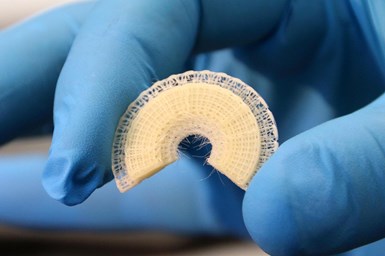Desktop Metal Launches Desktop Health for Patient-Specific Solutions
Health care business leverages Desktop Metal’s portfolio of AM solutions for current and future applications spanning dentistry, orthodontics, dermatology, orthopedics, cardiology, plastic surgery, and printed regenerative tissues and grafts.

A 3D printed miniscus scaffold.
Desktop Metal, a provider of mass production and turnkey additive manufacturing (AM) solutions, is launching Desktop Health, a business line focused on accelerating the growth of AM for dental, orthodontic and otolaryngology applications. The combination of new AM technologies — including bioprinting, high-speed metal binder jetting and the use of advanced biocompatible materials across polymers, ceramics and metals — puts Desktop Health in a unique position to develop advanced health care applications, the company says.
The initiative is built on a technology infrastructure for end-use parts production, which includes Digital Light Processing (DLP), Continuous Digital Light Manufacturing (cDLM) and high-speed metal binder jetting. Its mission is to create future patient-specific solutions in the medical field. The initiative is backed by 20 years of research, more than 1,400 published papers, and 3D Bioplotter and DLP technology, coupled with high-speed metal binder jetting AM solutions.
“Today, the world manufactures more than $85 billion in medical and dental implants each year,” says Ric Fulop, CEO and co-founder of Desktop Metal. “We think a large percentage of these parts could be printed and made patient-specific before the end of the decade.”
To lead this initiative, Desktop Metal has appointed Michael Mazen Jafar to president and CEO, Desktop Health. Jafar has nearly 20 years of experience creating and scaling health care products. Most recently he served as chief commercial officer of Evolus, a performance beauty company. Before that, Jafar led the ophthalmology and medical aesthetics division for Allergan.
“Our technology is widely used for customized in-office digital dentistry, makes customized metal implants possible and has enabled exploration of applications such as bone regeneration, cartilage regeneration and soft tissue biofabrication,” Jafar says. “We look forward to building on our success and ingenuity as we research extensions of our core technology across cardiology, orthopedics, ophthalmology, dermatology and plastic surgery.”
Related Content
-
8 Cool Parts From Formnext 2023: The Cool Parts Show #65
New additive manufacturing technologies on display at Formnext were in many cases producing notable end-use components. Here are some of the coolest parts we found at this year’s show.
-
Cranial Implant 3D Printed From Hydroxyapatite Ceramic: The Cool Parts Show #76
Cranial implants are typically made from titanium or PEEK; in this episode of The Cool Parts Show, we look at how implants made from a bioceramic can improve osseointegration and healing.
-
Ultra-Complex 3D Printed Scaffolds Enable Cell Growth: The Cool Parts Show #70
Perhaps the ultimate surface-area challenge is in bioengineering: creating structures that can grow sufficient cells within a compact volume to be effective for leading-edge medical treatments. The Southwest Research Institute develops bioreactor scaffolds that could only be made using 3D printing.














